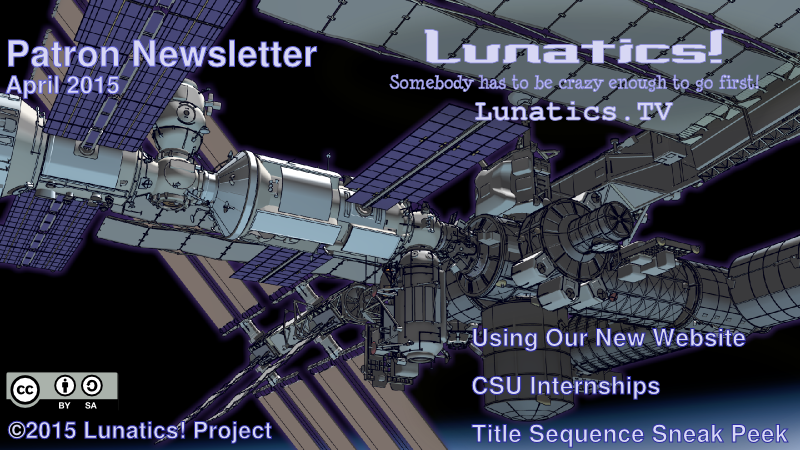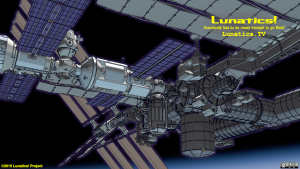Using Our New Website
I’m very pleased to be finally rolling out a revised website, based on WordPress, which will replace our old site, which was based on a combination of Plone and static web pages hosted in Zope. The old system was awkward to maintain and never quite worked as it should, because it’s just a little too hard to handle the maintenance without a dedicated development team.
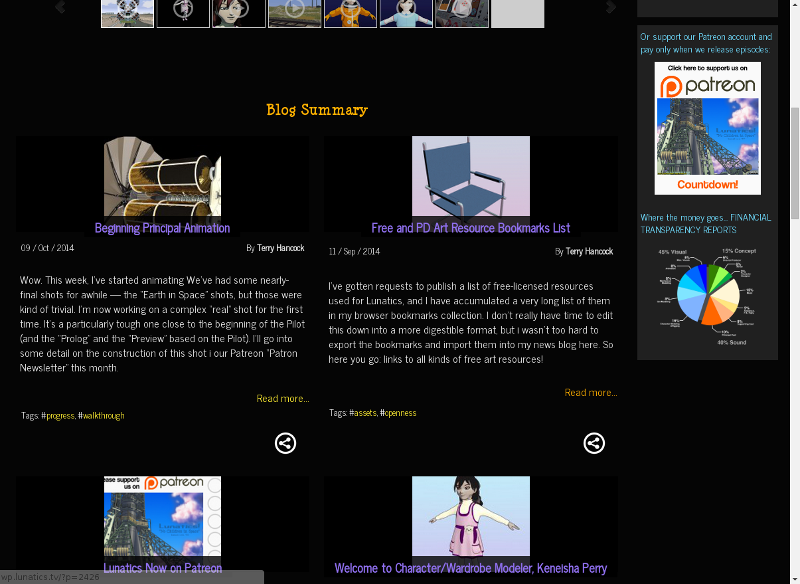
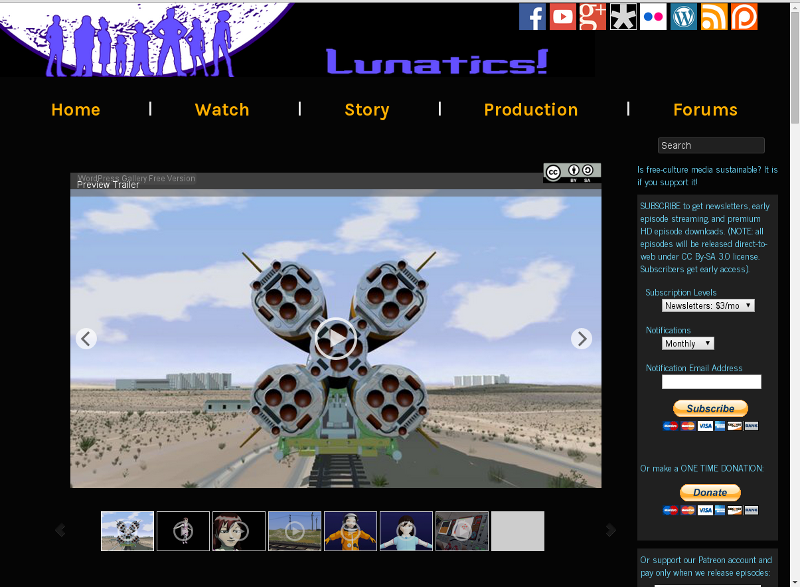
The new site emphasizes the blog, which was the main use we got out of Plone, but it’s now much better integrated with the rest of the site, which is all now implemented in WordPress, with a custom theme developed by Elsa Balderrama, which captures the most important parts of the old design, but allows for much better organization, and enough flexibility so we can keep up with project changes without having to re-engineer the whole site if we make minor changes.

In addition to collecting the Production Log from the old Plone site, the new log also contains copies of all of the Kickstarter updates we wrote to support our fundraising. This will also make it easier to have posts from different people on the project, rather than all being written by Terry Hancock. There’s also a tag cloud and a search feature to make it easier to find blog entries — all pretty standard stuff on a WordPress site, but stuff we’ve been missing!
In addition, the navigation is much improved, with easier access to the important project pages, and some of the obsolete material has been removed. We expect to make additional improvements over time, and the WordPress administrative environment makes updating the site quicker, so I hope this will be easier to keep up to date.
Most of the pages have associated categories which collect blog entries related to that page. Thus behind-the-scenes production articles are on the “Production” page and in-world articles about the characters will be found on the “Characters” sub-page under “Story”.
The actual production project part of the site is under “Production”, and the sub-pages here provide access to all of the resources used in production for the site. So this is basically the home page for project contributors. Under “Assets”, you’ll find the new Resource Space DAMS and and under “Source” you’ll find the old Trac/Subversion VCS site. There’s also links to the Production forum on our PHP BB site, and a page for “Business” concerns, such as business models and profit-sharing information as we develop it. New pages will be added here soon for teleconferencing software and script translations as we prepare for those tasks.
Resource Space and Trac
In addition to WordPress, we’re also rolling out a new Digital Asset Management System (DAMS) called Resource Space. This provide a more sophisticated way to track and organize digital content than a wiki, and it is easier to search and access than the project version control system (VCS) that we maintain with Trac and Subversion.
The distinction between DAMS and VCS may seem very subtle, and it may be even less clear why we need both on this project, but I’ll try to explain.
A DAMS operates very much like public data-driven websites you’ve used in the past (think of Flickr, Jamendo, BlendSwap, or DeviantArt — these are all essentially DAM Systems made accessible to the public. They provide an indexed, tagged, and thus searchable database of digital assets. Many different methods of search are possible, based on any of the metadata fields recorded for each object.
A VCS is primarily needed for highly-organized hierarchical projects, like software development. Most VCS packages (including Subversion, which is the one we use) do not provide very easy search capabilities, and so extracting a particular single element can be hard, as can finding it. On the other hand, the VCS does an excellent job of preserving the correct file-hierarchy relationhship. It also tracks the changes in a particular file, and can catch us when we accidentally have more than one person working on a file at a time (this is called a “conflict” when there are two competing versions of a file which are difficult if not impossible to merge into one file).
To illustrate the difference, let’s look at a file which occurs in both places for us. This is the Blender model of the Soyuz Orbiter (the exterior model — there is a different model for the interior set). First of all, let’s look at the page for this model in the Resource Space DAMS:
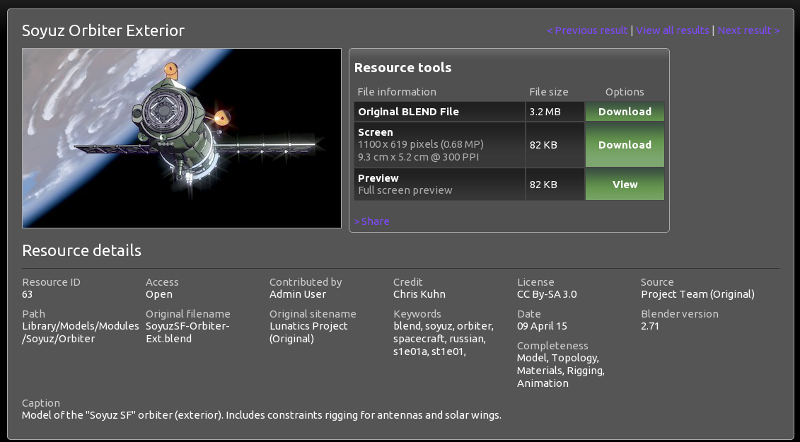
And here is the page for the same file as it appears in the Trac/Subversion Version Control System (VCS):
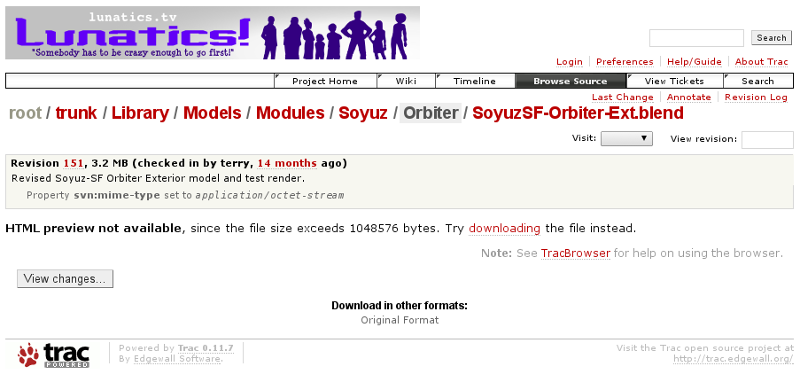
They are copies of the same file — you can download it from either site. But the two systems emphasize very different things for us. The DAMS treats the file as an asset in its own right, with metadata that can be used to find the file, and an automatic preview (the image is automatically created using Blender to render the first animation frame in the file). Whereas, the VCS emphasizes the editing history of the file and its relationship to the other files in the source tree. This is critical for the library linking system to work correctly for Blender files with linked elements. It’s also important for making sure we are using the correct version of the file (usually we want to make sure it’s the most up-to-date version.
The DAMS, however, is generally going to be more interesting for sharing assets for others to use, as it will be much easier to use individual models.
The DAMS also means we can keep a lot of files that aren’t necessarily in an episode (they may be used in the future, or maybe not), without having the source tree grow to ridiculous proportions. For people working the project, it may be necessary to download large portions of the source tree in order to “build” (i.e. render) particular shots and scenes. But with the DAMS, it’s easy to find and extract a particular Blend file or image or other element without having to download the whole database.
In the future, it may also be possible to accept community submissions through the DAMS, although we are still working out our procedures for this.
CSU Media Internship Program
One of the most exciting things to happen this month has been our getting accepted as an industry partner for the Calfornia State University system’s Media Internship program. This is a really great thing for several different reasons, both for us as an individual project and for free-culture film in general.
I’m excited for our project, of course, because these Interns will be working on this project over the Summer, which is going to give us an important boost to getting our pilot episode made. These are senior media major students who should be relatively skilled, and who will be putting in enough time to make a real difference on our project. This greatly increases my confidence that we can meet our proposed release schedule (or at least come close to it).
It also will set an interesting precedent for the acceptance of free-culture projects in general, because CSU is treating us as equals with commercial proprietary studios. This is an excellent chance to introduce the ideas of free-culture business into some up and coming media professionals. It’s a chance to prove ourselves worthy of that kind of treatment, and to give students a taste of what working in a free-culture business might be like. Perhaps they’ll take some of those ideas with them when they go on to other jobs in the entertainment industry. Perhaps they’ll want to start their own projects.
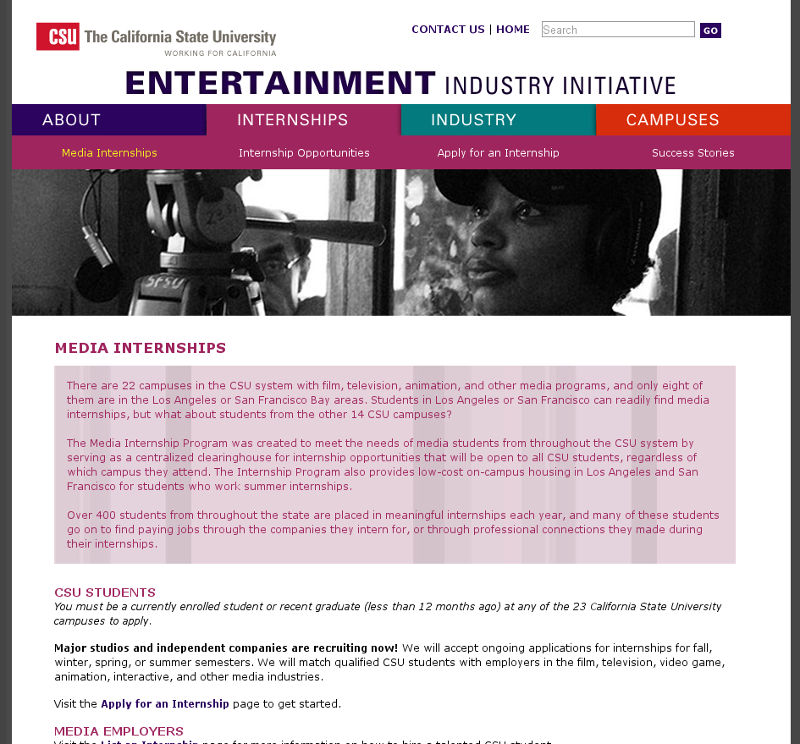
We’re also expanding opportunities for the students. CSU is not just in Los Angeles. It has campuses all over the state of California, and for many of those students, having to relocate or commute to jobs in the Greater Los Angeles area would be a hardship. Our project is the first 100% telecommute opportunity for CSU students, and thus we’re providing a new option for students who might have difficulty with on-site internships. We’re also going to be teaching them to work in an internet-collaborative way, which could be a very important skill set, especially for those who aspire to freelance careers.
We got involved in this program mainly because Keneisha Perry, who is now our primary character wardrobe and rigging expert, started out by working on a class-credit internship, and is just now starting her own senior internship with us. We had to get recognized by the school to meet that requirement, and naturally I felt I should see if there might be more potential student interns where she came from.
During this next week, I’ll be looking at applications from candidates interested in the internship, and I do hope we’ll find good matches. I’m certainly excited to find out.
We’ll be accepting 2-3 students to work on developing the primary sets for the series. These will mainly be the interior sets for the ISF-1 Colony and Iridium Base, which of course, we’ll see over and over in the series, and which we’ll first see in part 3 of the pilot story, “No Children in Space”.
We’ll also be accepting one student to work on sound production — most likely creating sound ambience mixes to go with the sets.
Sneak Peek at our Title Sequence
Since we are getting pretty close to releasing Part 1 of our pilot story, we’re going to need a title sequence to go with it. This probably will not be the same as the sequence that will be released with the whole story when it is combined into one episode, but it will be similar. I’ve made a rough draft version that may be what we run with Part 1. It’s likely that some parts of it will be polished more, but I am pretty happy with it already. The sketches at the beginning are meant to be sketches, not stand-ins for posed characters, although I’m debating whether to use these actual production sketches, or to use Freestyle-generated simulated sketches, with the possibility of animating them slightly.
Please note that, although some names and titles are certainly correct, these are not the final edit of the credits, they make certain assumptions about work not yet done, and there may be omissions! I will be making additional edits to this before release.
The credits for Part 1 of the pilot story will be a little unusual, since it is meant to be the “pre-credits teaser” for the finished full episode. So these credits will actually run after the end of the segment, with the “end credits roll” immediately following them. I haven’t quite decided whether to run the guest credits right after this sequence, or to edit them into this title sequence.
Rough draft of series credits, possibly usable as-is for the Part 1 release.
Other News
Last month, I already mentioned Elsa Balderrama joining the project. She’s already done some impressive work on the website redesign, but as the credits above note, she’ll probably be primarily associated with character animation.
I had already been talking to Monty King about doing foley sound and sound-mixing, but I wasn’t too sure whether he was going to commit to doing it, so I didn’t want to mention him by name then. At this point, though, we’re pretty sure he’ll be doing this sound work, although it’s one of the last production steps — which means we won’t have a proper “meet the team” post for him until after Part 1 is released. Nevertheless, I wanted to give an advance credit to him here in the newsletter!
